Priority Bundle
Can Priority Technology Holdings Maintain Its Momentum?
Priority Technology Holdings (PRTH) has emerged as a key player in the fintech space, revolutionizing how businesses manage payments. From its inception in 2005, the company has consistently expanded, evolving from a merchant acquirer to a comprehensive payment solutions provider. This journey raises critical questions about its Priority SWOT Analysis, future prospects, and the sustainability of its growth strategy.
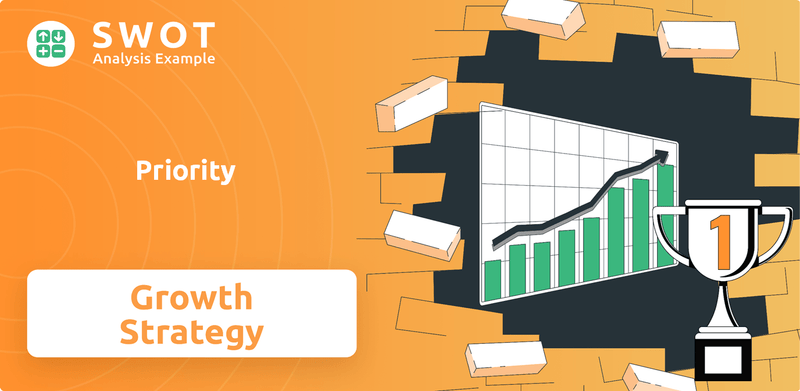
Understanding the growth strategy of a priority company like Priority Technology Holdings is crucial for investors and business strategists alike. This analysis delves into the company's strategic planning, examining its future prospects within the dynamic payment technology sector. We'll explore how Priority is navigating challenges and leveraging opportunities for business development to drive sustained company performance and unlock new revenue streams, offering insights into its long-term vision and market position.
How Is Priority Expanding Its Reach?
The company is actively pursuing several expansion initiatives to fuel future growth, focusing on strategic acquisitions, new product launches, and strengthening its presence in key market segments. This approach aims to enhance its service offerings and broaden its market reach.
A key element of this strategy is the acquisition of other companies. These acquisitions not only expand the range of services offered but also provide access to new markets and customer bases. This strategy is crucial for maintaining a competitive edge and increasing overall market share.
The company's expansion strategy is also centered on growing its high-margin B2B and enterprise segments. This focus reflects a strategic shift towards more profitable areas of the business. In Q1 2025, the B2B segment saw a 12% increase in revenue, while the enterprise segment grew by 22% year-over-year.
The acquisition of Rollfi in January 2025 added payroll and benefit solutions to the company's existing suite of services. This acquisition is designed to integrate payroll and benefits into their offerings, thereby expanding the company's value proposition.
The company is expanding its Unified Commerce Platform. This platform streamlines ticket payments and drives new revenue. The company is also exploring other financial technology areas to accelerate growth.
The company's growth strategy includes several key initiatives to drive future success. These initiatives are designed to capitalize on market opportunities and enhance the company's overall performance. For more insights into the company's target market, you can read about the Target Market of Priority.
- Acquisition of Rollfi to integrate payroll and benefits.
- Focus on high-margin B2B and enterprise segments.
- Expansion of the Unified Commerce Platform.
- Strategic acquisitions in sub-scale SaaS businesses.
Priority SWOT Analysis
- Complete SWOT Breakdown
- Fully Customizable
- Editable in Excel & Word
- Professional Formatting
- Investor-Ready Format
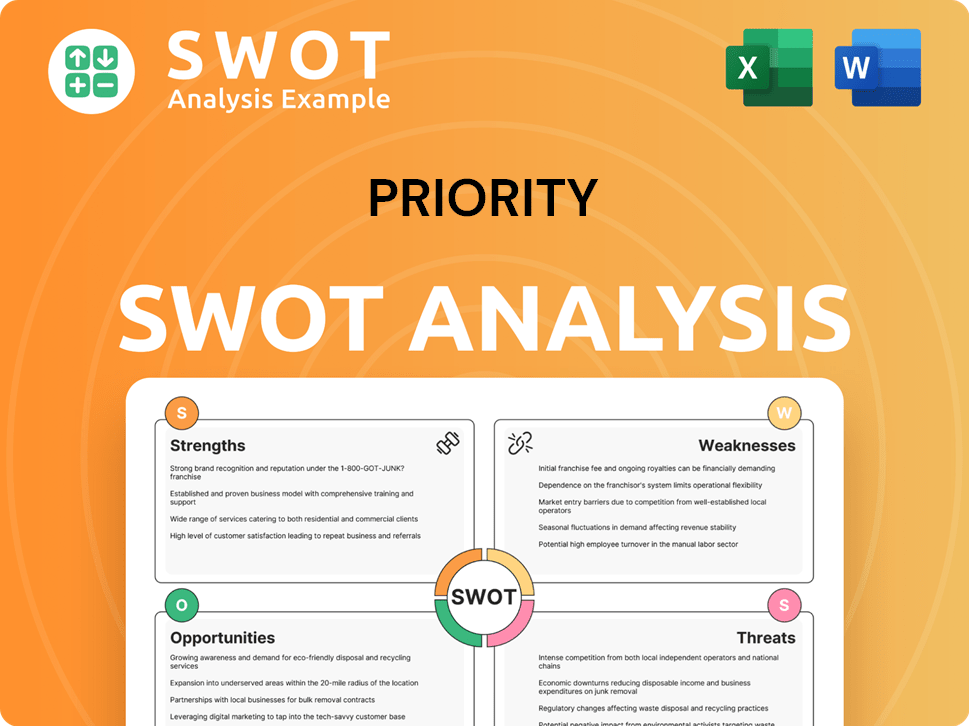
How Does Priority Invest in Innovation?
The Priority company leverages innovation and technology to drive its growth strategy. Its core focus is on the 'Priority Commerce Engine,' a unified platform designed to streamline financial processes. This platform aims to accelerate cash flow and optimize working capital for its customers, which is a critical need in today's fast-paced business environment.
The company's approach emphasizes a scalable and innovative technology platform. This platform has low capital spending needs, which supports strong revenue growth and significant operating leverage. This strategy allows the company to efficiently manage its resources while expanding its service offerings.
The company's commitment to digital transformation is evident in its unified commerce platform, which covers acquiring, payables, and banking. This platform aims to modernize legacy systems and accelerate software partners' strategies to monetize payments through its embedded finance and Banking as a Service (BaaS) solutions. Furthermore, the company's leadership has a strong track record of identifying opportunities ahead of its peers, which is crucial for long-term success.
The 'Priority Commerce Engine' is central to the company's technological strategy. This platform is designed to streamline financial operations, providing a comprehensive solution for its customers. The platform's architecture supports scalability and efficiency.
The company is focused on modernizing legacy platforms and integrating innovative offerings. This includes expanding its platform's capabilities through acquisitions and leveraging APIs. The acquisition of Rollfi in January 2025 is a prime example of this strategy.
The company is actively engaged in digital transformation across its operations. This involves a unified commerce platform that encompasses acquiring, payables, and banking services. The goal is to provide a seamless and integrated financial experience.
The company's B2B and enterprise segments have demonstrated strong growth. Revenue in these segments increased by 12% and 22% respectively in Q1 2025. This growth indicates the effectiveness of its strategic initiatives.
The fintech industry is increasingly prioritizing AI and IoT. While not explicitly stated for the Priority company, its position as a fintech solution provider suggests an alignment with these trends. Staying competitive and enhancing offerings is key.
The leadership team has a proven track record of identifying market opportunities. This proactive approach is crucial for sustaining future prospects and navigating the dynamic tech landscape. This foresight helps the company stay ahead of its competitors.
The Priority company's growth strategy is heavily reliant on technological innovation and strategic acquisitions. This approach allows it to expand its service offerings and enhance its market position. A thorough market analysis is essential for identifying opportunities and mitigating risks.
- Focus on the 'Priority Commerce Engine' to streamline financial processes.
- Acquisition of Rollfi to integrate new payroll and benefit solutions.
- Emphasis on digital transformation across acquiring, payables, and banking.
- Leveraging embedded finance and BaaS solutions to monetize payments.
- Capitalizing on industry trends such as AI and IoT to remain competitive.
- Strong revenue growth in B2B and enterprise segments.
For more insights into the company's background and development, consider reading the Brief History of Priority.
Priority PESTLE Analysis
- Covers All 6 PESTLE Categories
- No Research Needed – Save Hours of Work
- Built by Experts, Trusted by Consultants
- Instant Download, Ready to Use
- 100% Editable, Fully Customizable
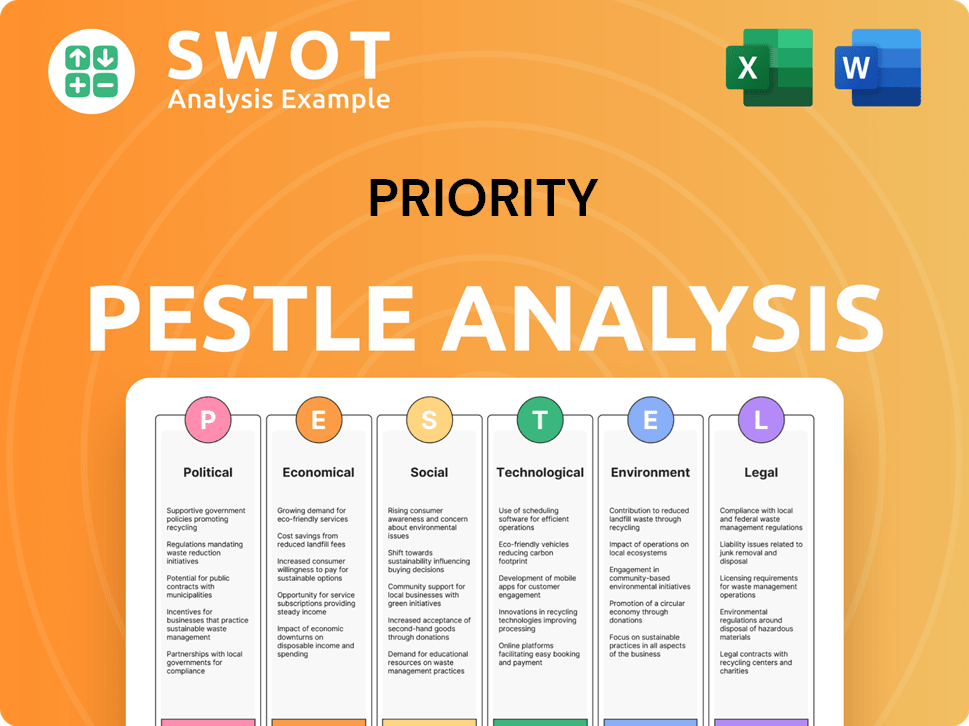
What Is Priority’s Growth Forecast?
The financial outlook for Priority Technology Holdings is robust, with a focus on sustained growth. The company's strategic planning includes ambitious revenue and profitability targets for 2025. This outlook is supported by strong performance in key business segments and effective business development initiatives.
For the full year 2025, Priority projects significant revenue growth, indicating a strong trajectory. The company's strategic planning is designed to capitalize on market opportunities and enhance company performance. These projections reflect the company's commitment to long-term growth and value creation.
In Q1 2025, Priority demonstrated solid financial results, with increases in revenue and adjusted EBITDA. This strong start to the year sets a positive tone for achieving its growth strategy goals. The company's focus on operational efficiency and strategic planning contributes to its positive financial outlook.
For 2025, Priority anticipates revenue between $965 million and $1 billion. This represents a growth rate of 10% to 14% compared to 2024 results. This growth is a key indicator of the company's expansion strategies and market success.
Adjusted gross profit is expected to be between $360 million and $385 million. This reflects a growth rate of 10% to 17% over 2024. This financial metric highlights the company's profitability and operational efficiency.
Adjusted EBITDA is projected to range from $220 million to $230 million. This indicates an 8% to 13% growth compared to the fiscal year 2024. This demonstrates the company's strong financial health and strategic planning.
In Q1 2025, revenue reached $224.6 million, a 9% year-over-year increase. Adjusted gross profit grew by 14%, reaching $87.3 million. Adjusted EBITDA for the quarter was $51.3 million, an 11% improvement.
The company's net leverage at the end of Q1 2025 was 4.2 times, down from 4.3 times at the end of 2024, showing improved financial stability. Priority's commitment to reducing debt is evident in its voluntary prepayment of $10 million on its term loan in February 2025. This proactive approach to financial management supports its long-term growth strategy.
Full-year 2024 revenue was $879.7 million, a 16% increase year-over-year. Adjusted gross profit increased by 19% to $328.1 million. Adjusted EBITDA grew by 21% to $204.3 million.
The company anticipates that its earnings per share (EPS) could potentially double to around $1 per share in 2025. This is based on normal course growth and reflects the company's positive trajectory.
The B2B and enterprise segments contributed 62% of adjusted gross profit in Q1 2025. This highlights the importance of these segments to the company's overall financial performance and future prospects.
Net leverage decreased from 4.3x at the end of 2024 to 4.2x at the end of Q1 2025. The company made a $10 million voluntary prepayment on its term loan in February 2025, demonstrating a commitment to reducing debt.
Priority's financial goals for 2025 include significant revenue growth and improved profitability. The company's strategic planning is designed to achieve these goals through operational excellence and market expansion.
Key performance indicators (KPIs) for Priority include revenue growth, adjusted gross profit, and adjusted EBITDA. Monitoring these metrics is crucial for assessing the company's progress and ensuring the success of its growth strategy.
Priority Business Model Canvas
- Complete 9-Block Business Model Canvas
- Effortlessly Communicate Your Business Strategy
- Investor-Ready BMC Format
- 100% Editable and Customizable
- Clear and Structured Layout
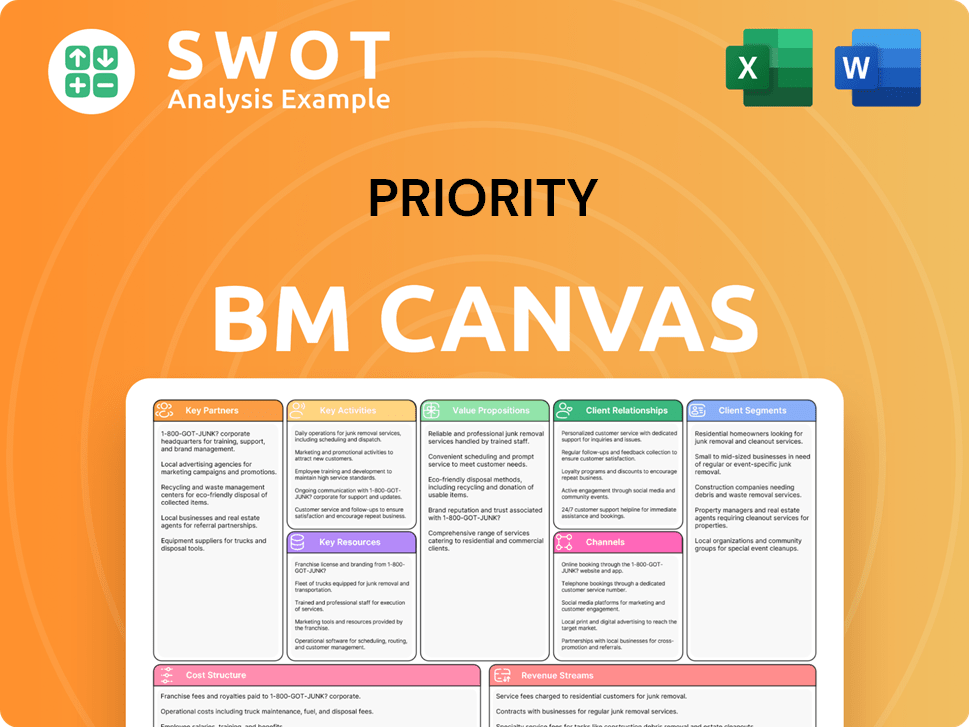
What Risks Could Slow Priority’s Growth?
The fintech sector, where Priority Technology Holdings operates, presents several potential risks and obstacles that could affect its growth strategy and overall company performance. Understanding these challenges is crucial for evaluating the company's future prospects and developing effective strategic planning.
Market competition is a constant pressure, necessitating continuous innovation and expansion of offerings to maintain a competitive edge. Regulatory changes in the payments and financial services industry also pose significant risks. The company must proactively adapt to stay ahead.
Technological disruption is another key risk. The rapid pace of innovation in fintech could lead to new technologies or business models. Mitigation involves focusing on its 'unified commerce engine' and continuously evolving its platform.
The fintech market is highly competitive, with numerous players vying for market share. Maintaining a competitive edge requires continuous innovation and the ability to anticipate market trends. This can be a challenge for any priority company.
The financial services industry is heavily regulated, and changes in regulations can significantly impact operations. Compliance costs and the need to adapt to new rules can strain resources and affect profitability. This is an important factor in business development.
The fintech sector is subject to rapid technological advancements. New technologies and business models can quickly render existing solutions obsolete. Staying ahead requires significant investment in R&D and a flexible approach.
While not specifically detailed for payment technology services, supply chain disruptions could affect the operational efficiency of businesses served. This could indirectly impact transaction volumes and revenue. Understanding the impact is key for strategic planning.
Talent shortages in specialized tech areas could hinder development and expansion. Attracting and retaining skilled employees is crucial for innovation and growth. This is a challenge for many companies.
The macroeconomic environment, including interest rates and economic growth, can influence the company's performance. Economic downturns or changes in interest rates can affect transaction volumes and profitability. For more information on how to navigate these challenges, see Marketing Strategy of Priority.
In Q1 2025, the company demonstrated strong financial performance despite economic uncertainty. This performance reflects the company's ability to navigate challenges. The success highlights effective risk management strategies.
The redemption of preferred stock in 2024 allowed all net income to flow to common shareholders. This simplified the capital structure and improved adjusted EPS. This strategic move can increase shareholder value.
Potential headwinds related to lower interest rates and a murky macroeconomic environment are emerging risks. The company acknowledges these risks in its guidance. Proactive planning is crucial to mitigate these risks.
A disclosed material weakness in internal controls over financial reporting was noted. This was addressed without restating financial results. The company's response demonstrates a commitment to financial integrity.
Priority Porter's Five Forces Analysis
- Covers All 5 Competitive Forces in Detail
- Structured for Consultants, Students, and Founders
- 100% Editable in Microsoft Word & Excel
- Instant Digital Download – Use Immediately
- Compatible with Mac & PC – Fully Unlocked
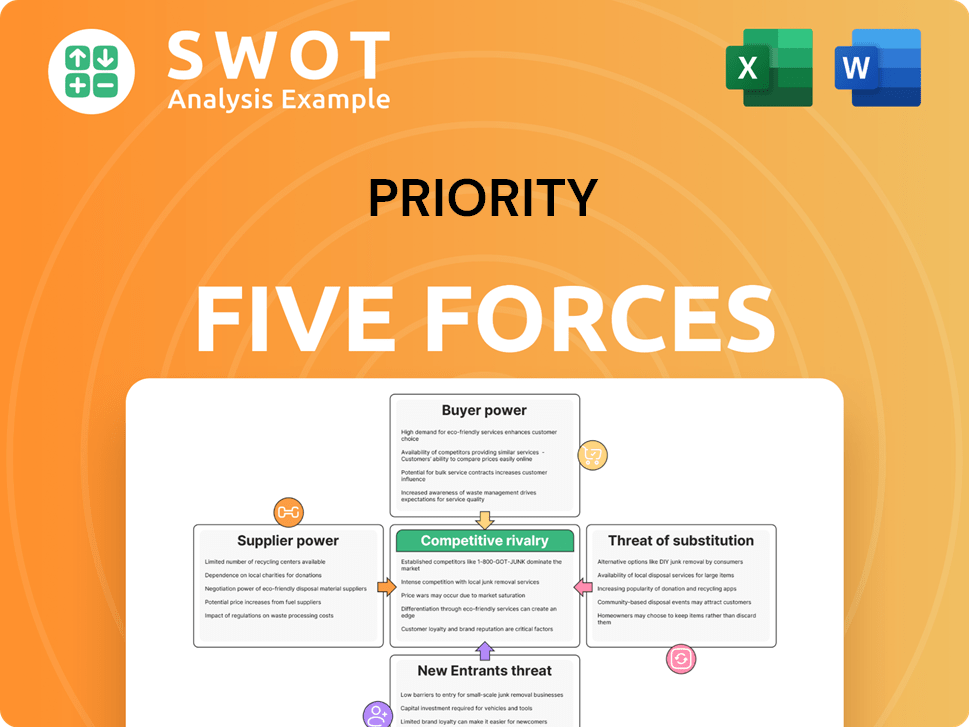
Related Blogs
- What are Mission Vision & Core Values of Priority Company?
- What is Competitive Landscape of Priority Company?
- How Does Priority Company Work?
- What is Sales and Marketing Strategy of Priority Company?
- What is Brief History of Priority Company?
- Who Owns Priority Company?
- What is Customer Demographics and Target Market of Priority Company?
Disclaimer
All information, articles, and product details provided on this website are for general informational and educational purposes only. We do not claim any ownership over, nor do we intend to infringe upon, any trademarks, copyrights, logos, brand names, or other intellectual property mentioned or depicted on this site. Such intellectual property remains the property of its respective owners, and any references here are made solely for identification or informational purposes, without implying any affiliation, endorsement, or partnership.
We make no representations or warranties, express or implied, regarding the accuracy, completeness, or suitability of any content or products presented. Nothing on this website should be construed as legal, tax, investment, financial, medical, or other professional advice. In addition, no part of this site—including articles or product references—constitutes a solicitation, recommendation, endorsement, advertisement, or offer to buy or sell any securities, franchises, or other financial instruments, particularly in jurisdictions where such activity would be unlawful.
All content is of a general nature and may not address the specific circumstances of any individual or entity. It is not a substitute for professional advice or services. Any actions you take based on the information provided here are strictly at your own risk. You accept full responsibility for any decisions or outcomes arising from your use of this website and agree to release us from any liability in connection with your use of, or reliance upon, the content or products found herein.